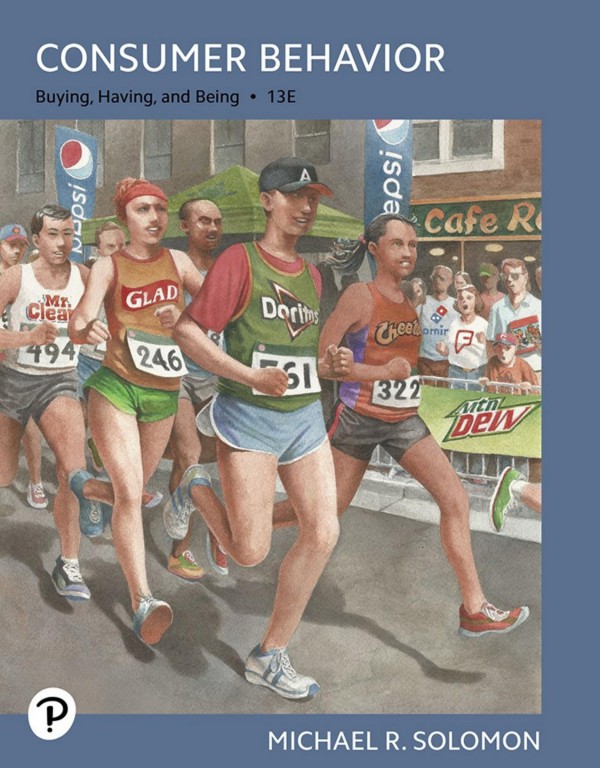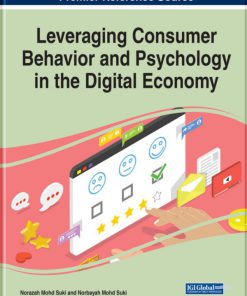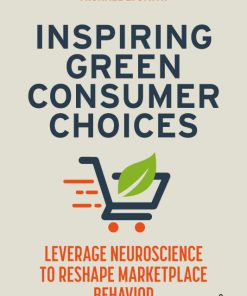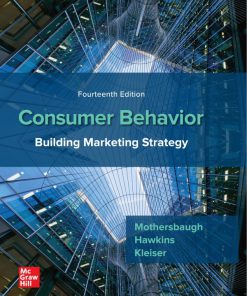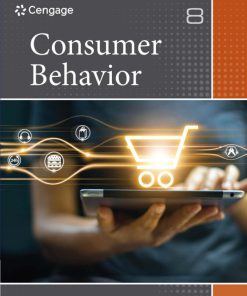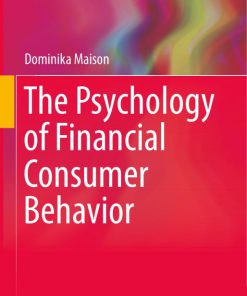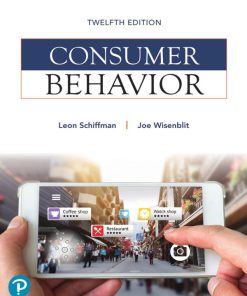Consumer Behavior Buying Having Being 13th Edition by Michael Solomon 0135225698 9780135225691
$50.00 Original price was: $50.00.$25.00Current price is: $25.00.
Authors:Michael R. Solomon , Series:Management [827] , Author sort:Solomon, Michael R. , Languages:Languages:eng , Published:Published:Dec 2018 , Publisher:Pearson
Consumer Behavior Buying Having Being 13th Edition by Michael Solomon – Ebook PDF Instant Download/Delivery. 0135225698, 9780135225691
Full download Consumer Behavior Buying Having Being 13th Edition after payment
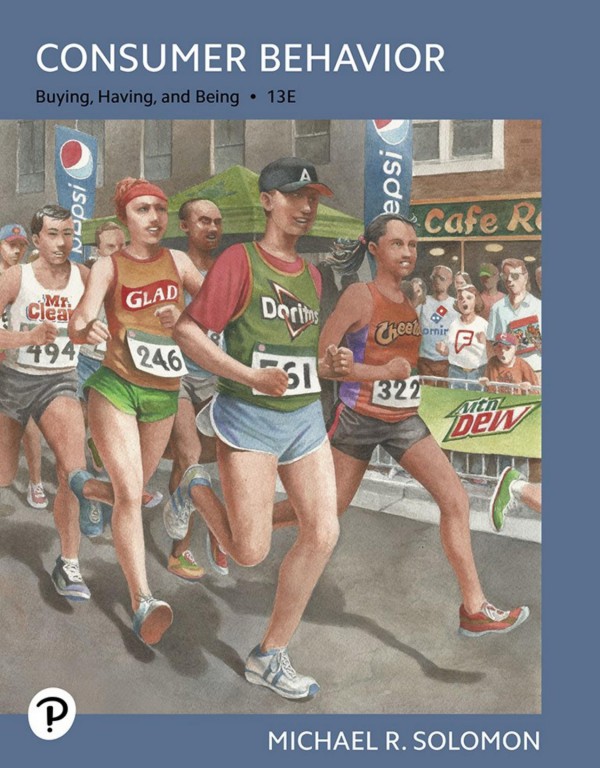
Product details:
ISBN 10: 0135225698
ISBN 13: 9780135225691
Author: Michael Solomon
Consumer Behavior: Buying, Having, Being (Pearson+)
Pearson+ gives you access to much more than your eTextbook. Most titles also include audiobooks, study notes, flashcards and more to help you thrive in the classroom.
For consumer behavior courses.
Beyond consumer behavior: How buying habits shape identity
Consumer Behavior: Buying, Having, and Being covers what happens before, during and after the point of purchase. It investigates how having or not having certain products affects our lives, especially in the canon of social media and the digital age.
In the 13th Edition, up-to-date content reflects major marketing trends and changes that impact this field of study. Since we are all consumers, many of the topics have both professional and personal relevance to students. This makes it easy to apply the theory outside of class and maintain an edge in the fluid and evolving field of consumer behavior.
Consumer Behavior Buying Having Being 13th Table of contents:
Section 1 Foundations of Consumer Behavior
1 Buying, Having, and Being: An Introduction to Consumer Behavior
Chapter Objectives
Consumer Behavior: People in the Marketplace
What Is Consumer Behavior?
Consumer Behavior Is a Process
Consumers’ Impact on Marketing Strategy
Consumers Are Different! How We Divide Them Up
User-Generated Content (UGC)
Marketing’s Impact on Consumers
Popular Culture Is Marketing Is Popular Culture . . .
All the World’s a Stage
What Does It Mean to Consume?
The Global “Always-On” Consumer
The Digital Native: Living a Social [Media] Life
Consumer Behavior as a Field of Study
Where Do We Find Consumer Researchers?
Interdisciplinary Influences on the Study of Consumer Behavior
Two Perspectives on Consumer Research
Consumer Trends: Keep Ahead to Keep Up
Taking It from Here: The Plan of the Book
Chapter Summary
Key Terms
Review
Consumer Behavior Challenge
Discuss
Apply
Notes
2 Consumer Well-Being
Chapter Objectives
Business Ethics and Consumer Rights
Needs and Wants: Do Marketers Manipulate Consumers?
Do Marketers Create Artificial Needs?
A Response.
Is Marketing Necessary?
A Response.
Do Marketers Promise Miracles?
A Response.
Consumers’ Rights and Product Satisfaction
Market Regulation
Consumerism
Corporate Social Responsibility (CSR)
Transformative Consumer Research
Social Marketing
Major Policy Issues Relevant to Consumer Behavior
Data Privacy and Identity Theft
Market Access
Disabilities
Food Deserts
Literacy
Sustainability and Environmental Stewardship
The Dark Side of Consumer Behavior
Consumer Terrorism
Addictive Consumption
Compulsive Consumption
Consumed Consumers
Illegal Acquisition and Product Use
Consumer Theft and Fraud
Anticonsumption
Chapter Summary
Key Terms
Review
Consumer Behavior Challenge
Discuss
Apply
Notes
Background
Your Goal
The Data
Task 1: Correct the Table:
Task 2: Making Inferences about Athletic Shoe Buyers
Task 3: Estimating the Value of the Shoe Buying Segments
Discussion and Debate
Section 2 Internal Influences on Consumer Behavior
3 Perception
Chapter Objectives
Sensation
Sensory Marketing
Vision
Dollars and Scents
Sound
Touch
Taste
Augmented and Virtual Reality
The Stages of Perception
Stage 1: Exposure
Sensory Thresholds
Subliminal Perception
Stage 2: Attention
Multitasking
Personal Selection Factors
Stage 3: Interpretation
Stimulus Organization
Semiotics: The Meaning of Meaning
What’s Your Emoji?
Hyperreality
Perceptual Positioning
Chapter Summary
Key Terms
Review
Consumer Behavior Challenge
Discuss
Apply
Notes
4 Learning and Memory
Chapter Objectives
How Do We Learn?
Behavioral Learning Theories
Classical Conditioning
Stimulus Generalization
Stimulus Discrimination
Marketing Applications of Classical Conditioning Principles
Marketing Applications of Repetition
Marketing Applications of Conditioned Product Associations
Marketing Applications of Stimulus Generalization
Instrumental Conditioning
Marketing Applications of Instrumental Conditioning Principles
Gamification: The New Frontier for Learning Applications
Cognitive Learning Theory
Observational Learning
Is Learning Conscious or Not?
Marketing Applications of Cognitive Learning Principles
How Do We Learn to Be Consumers?
Parents’ Influence
Television and the Internet: Electronic Babysitters
Cognitive Development
Message Comprehension
Memory
How Our Brains Encode Information
Sensory Memory
Short-Term Memory
Long-Term Memory
How Our Memories Store Information
Associative Networks
How We Retrieve Memories When We Decide What to Buy
What Makes Us Forget?
State-Dependent Retrieval
Familiarity and Recall
Salience and Recall
The Viewing Context
Pictorial Versus Verbal Cues
How We Measure Consumers’ Recall of Marketing Messages
Recognition versus Recall
Problems with Memory Measures
Memory Lapses
Bittersweet Memories: The Marketing Power of Nostalgia
Key Terms
Review
Consumer Behavior Challenge
Discuss
Apply
Notes
5 Motivation and Affect
Chapter Objectives
The Motivation Process: Why Ask Why?
Motivational Strength
Drive Theory
Expectancy Theory
Motivational Direction
Needs versus Wants
Motivational Conflicts
Approach–Approach Conflict
Approach-Avoidance Conflict
Avoidance-Avoidance Conflict
How We Classify Consumer Needs
Murray’s Psychogenic Needs
Specific Needs and Buying Behavior
Maslow’s Hierarchy of Needs
Affect
Types of Affective Responses
Mood Congruency
Positive Affect
Happiness
Negative Affect
Disgust
Envy
Guilt
Embarrassment
How Social Media Tap into Our Emotions
Consumer Involvement
Types of Involvement
Product Involvement
Strategies to Increase Product Involvement
Message Involvement
Strategies to Increase Message Involvement
Situational Involvement
Strategies to Increase Situational Involvement
Chapter Summary
Key Terms
Review
Consumer Behavior Challenge
Discuss
Apply
Notes
6 The Self: Mind, Gender, and Body
Chapter Objectives
The Self
Does the Self Exist?
Self-Concept
Self-Esteem
Real and Ideal Selves
Fantasy: Bridging the Gap Between the Selves
Multiple Selves
The Looking-Glass Self
Self-Consciousness
Are We What We Buy?
The Extended Self
Embodied Cognition
Wearable Computing
Gender Identity
Sex Role Socialization
Gender Identity versus Sexual Identity
Sex-Typed Products
Female Sex Roles
Male Sex Roles
Androgyny
Lesbian, Gay, Bisexual, and Transgender (LGBT) Consumers
The Body as Product
Ideals of Beauty
Is Beauty Universal?
Ideals of Female Beauty Evolve over Time
The Western Ideal of Female Beauty
What Is Today’s Ideal of Female Beauty?
Fattism and Body Positivity
Ideals of Male Beauty
Body Decoration and Mutilation
Body Anxiety
Cosmetic Surgery
Tattoos
Body Piercing
Chapter Summary
Key Terms
Review
Consumer Behavior Challenge
Discuss
Apply
Notes
7 Personality, Lifestyles, and Values
Chapter Objectives
Personality
Consumer Behavior on the Couch: Freudian Theory
Freudian Systems
“Sometimes a Cigar Is Just a Cigar”: Products as Sexual Symbols
Motivational Research
Neo-Freudian Theories
Karen Horney
Carl Jung
Trait Theory
The Big Five Personality Traits
Problems with Trait Theory in Consumer Research
Brand Personality
Lifestyles and Consumer Identity
Product Complementarity and Co-Branding Strategies
Psychographics
Values
Core Values
The Value of Materialism: Are You What You Own?
How Do Values Link to Consumer Behavior?
The Rokeach Value Survey
The List of Values (LOV)
The Means–End Chain Model
Syndicated Surveys
Chapter Summary
Key Terms
Review
Consumer Behavior Challenge
Discuss
Apply
Notes
Section 3 Choosing and Using Products
8 Attitudes and Persuasive Communications
Chapter Objectives
The Power of Attitudes
The ABC Model of Attitudes
Hierarchies of Effects
The High-Involvement Hierarchy:
The Low-Involvement Hierarchy:
The Experiential Hierarchy:
How Do We Form Attitudes?
Attitude Models
Multiattribute Attitude Models
Marketing Applications of the Multiattribute Model
Capitalize on Relative Advantage.
Do Attitudes Predict Behavior?
Intentions Versus Behavior
Obstacles to Predicting Behavior in the Theory of Reasoned Action
Persuasion: How Do Marketers Change Attitudes?
Decisions, Decisions: Tactical Communications Options
The Elements of Communication
An Updated View: Interactive Communications
The Source
Source Credibility
Source Attractiveness: “What Is Beautiful Is Good”
Star Power: Celebrities As Communications Sources
Nonhuman Endorsers
The Message
Should We Use Pictures or Words?
Should We Repeat the Message?
How Do We Structure the Argument?
Should We Compare Our Product to Our Competitors’?
New Message Formats: The Social Media Revolution
Reality Engineering
Product Placement
Advergaming
Types of Message Appeals
Emotional Versus Rational Appeals
Sex Appeals
Humor Appeals
Fear Appeals
The Message as Art Form: Metaphors Be with You
The Source Versus the Message: Do We Sell the Steak or the Sizzle?
The Central Route to Persuasion
The Peripheral Route to Persuasion
Chapter Summary
Key Terms
Review
Consumer Behavior Challenge
Discuss
Apply
Notes
9 Decision Making
Chapter Objectives
What’s Your Problem?
Hyperchoice: Too Much of a Good Thing!
Self-Regulation
Cognitive Decision Making
Steps in the Cognitive Decision-Making Process
Step 1: Problem Recognition
Step 2: Information Search
Step 3: Evaluate Alternatives
Step 4: Product Choice
Step 5: Postpurchase Evaluation
Neuromarketing
Online Decision Making
How Do We Put Products into Categories?
Strategic Implications of Product Categorization
Position a Product.
Identify Competitors.
Create an Exemplar Product.
Locate Products in a Store.
Evaluative Criteria
The Power of Authenticity
Decision Rules
Habitual Decision Making
Heuristics: Mental Shortcuts
Covariation
Country of Origin
Familiar Brand Names
Higher Prices
AI: Who’s Calling the Shots?
Priming and Nudging
Chapter Summary
Key Terms
Review
Consumer Behavior Challenge
Discuss
Apply
Notes
10 Buying, Using, and Disposing
Chapter Objectives
Situational Effects on Consumer Behavior
The Consumption Situation
Temporal Factors
The Shopping Experience
Mood
When the Going Gets Tough, the Tough Go Shopping
E-Commerce: Clicks versus Bricks
From Bricks to Clicks
From Clicks Back to Bricks
Digital Currency
Retailing As Theater
Store Image
Atmospherics
In-Store Decision Making
Shopping Apps and In-Store Tech
Spontaneous Shopping
Point-of-Purchase Stimuli
The Salesperson: A Lead Role in the Play
Ownership and the Sharing Economy
Postpurchase Satisfaction and Disposal
Postpurchase Satisfaction
Product Disposal
Recycling and the Underground Economy
Chapter Summary
Key Terms
Review
Consumer Behavior Challenge
Discuss
Apply
Notes
Section 4 Consumers in Their Social and Cultural Settings
11 Group Influences and Social Media
Chapter Objectives
Groups
Social Power
Reference Groups
Conformity
Brand Communities
Collective Decision Making: How Groups Influence What We Buy
B2B Decision Making
How Does B2B Decision Making Compare with Consumer Decision Making?
B2B E-Commerce
Agile Marketing: B2B at High Speed
The Intimate Corporation: Family Decision Making
How Families Decide
Word-of-Mouth Communication
Buzz Building
Negative WOM
Opinion Leadership
How Influential Is an Opinion Leader?
Types of Opinion Leaders
The Market Maven
The Surrogate Consumer
Product Curators
How Do We Find Opinion Leaders?
Self-Designation
Sociometry: The Kevin Bacon Phenomenon
Social Media: The Horizontal Revolution
Online Social Networks and Brand Communities
Social Games
Digital Word-of-Mouth
Why Do We Post?
Influencer Marketing
Chapter Summary
Key Terms
Review
Consumer Behavior Challenge
Discuss
Apply
Notes
12 Income and Social Class
Chapter Objectives
Income and Consumer Identity
To Spend or Not to Spend, That Is the Question
Consumer Confidence
Income Inequality and Social Mobility
The Great Recession and Materialism
Income-Based Marketing
Targeting the Top of the Pyramid: High-Income Consumers
Targeting the Bottom of the Pyramid: Low-Income Consumers
Social Class and Consumer Identity
Pick a Pecking Order
Social Stratification
Income versus Social Class
How Do We Measure Social Class?
Status Symbols and Social Capital
Status Symbols
“What Do You Use That Fork For?” Taste Cultures and Codes
Social and Cultural Capital
Online Social Capital
Social Class Around the World
China
Japan
The Middle East
The United Kingdom
India
Brazil
Status Signaling
Chapter Summary
Key Terms
Review
Consumer Behavior Challenge
Discuss
Apply
Notes
13 Subcultures
Chapter Objectives
Ethnic and Racial Subcultures
Subcultural Stereotypes
Ethnicity and Acculturation
The “Big Three” American Ethnic Subcultures
African Americans
Hispanic Americans
Asian Americans
Religious Subcultures
Organized Religion and Consumption
Born Again Consumers
Islamic Marketing
The Family Unit and Age Subcultures
Family Structure
Age Cohort
Children: Consumers-in-Training
Gen Y and Gen Z
Gen Z
Gen Y
Gen X
The Mature Market
Baby Boomers
Seniors
Place-Based Subcultures
Chapter Summary
Key Terms
Review
Consumer Behavior Challenge
Discuss
Apply
Notes
14 Culture
Chapter Objectives
Cultural Systems
Dimensions of Culture
The Yin and Yang of Marketing and Culture
Cultural Movement
High and Low Culture
Cultural Formulae
Cultural Stories and Ceremonies
Myths
Rituals
Gift-Giving Ritual
Holiday Rituals
Rites of Passage
Sacred and Profane Consumption
Sacralization
Domains of Sacred Consumption
Sacred Places
Sacred People
Sacred Events
From Sacred to Profane, and Back Again
The Diffusion of Innovations
How Do We Decide to Adopt an Innovation?
Behavioral Demands of Innovations
What Determines If an Innovation Will Diffuse?
The Fashion System
Behavioral Science Perspectives on Fashion
Psychological Models of Fashion
Economic Models of Fashion
Sociological Models of Fashion
A Medical Model of Fashion
People also search for Consumer Behavior Buying Having Being 13th:
consumer behavior buying having and being 13th edition pdf free
why is consumer behavior important
what is consumer buying behaviour
consumer behavior buying having being solomon 13th edition pearson
You may also like…
eBook PDF
Social Psychology of Consumer Behavior 1st Edition by Michaela Wanke 1138882941 9781138882942
eBook PDF
Consumer Behavior 12th Edition by Leon Schiffman, Joseph Wisenblit ISBN 9780137504503 0137504500

